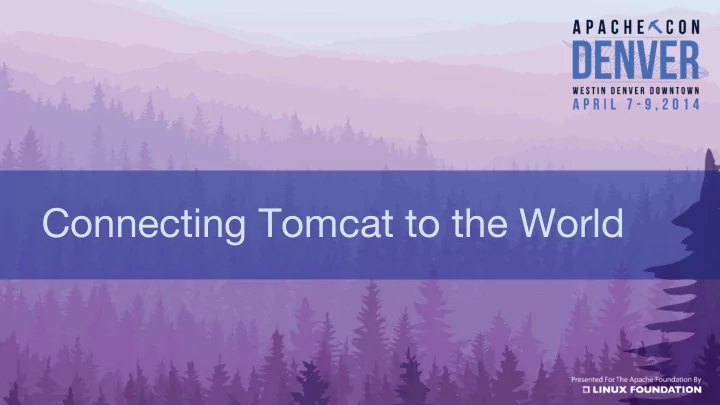

Connecting Tomcat to the World
What is a Connector? ● Tomcat's interface to the world ● Binds to a port ● Understands a protocol ● Dispatches requests
Tomcat Connectors ● Java Blocking I/O (BIO or sometimes JIO) ● Java Non-blocking I/O (NIO) ● Native / Apache Portable Runtime (APR) ● Java NIO.2
Types of I/O ● Polling ○ Straightforward API (peek) ○ CPU-inefficient ○ Thread loops while waiting for data ● Blocking ○ Straightforward API (streams) ○ CPU-efficient (blocking) ○ Thread stalls while waiting for data
Types of I/O ● Non-blocking ○ Complicated API (registration, event callbacks) ■ Channel ■ Buffer ■ Selector ○ CPU-efficient ○ Thread does not block: execution continues ○ When data is ready, the selector notifies observers
Common Connector Features ● Support for all protocols ○ HTTP, AJP, Websocket ● Support for all dispatch methods ○ Standard, Comet, Servlet 3.0 async ● Support for HTTPS (SSL/TLS) ● Acceptor thread(s) call accept() and hand-off ● Request processor thread pool
Blocking I/O Connector ● All I/O operations are blocking in processor thread ○ SSL handshake ○ Read request line (e.g. GET, POST, etc.) ○ Read request body ○ Write response ○ Read next request (HTTP keep-alive) ● Simple, stable, mature
Blocking I/O Connector ● Request throughput limited by thread count ● Clients can waste threads ○ Slow request line (mobile) ○ Aborted keep-alive stalls thread (default=20sec!) ● Unfair: accepted connections get priority for keep-alive requests
Blocking I/O Connector ● Single thread handles request after accept ● Uses Java Secure Sockets Extension (JSSE) for SSL/TLS
Non-blocking I/O Connector ● Single thread handles request after request-line ● Poller thread(s) manage non-blocking Selector ○ Read SSL handshake ○ Read request line ○ Wait for next keep-alive request
Non-blocking I/O Connector ● Block poller simulates blocking ○ Request header/body reads ○ Response writes ○ Processor thread sleeps during sim-blocking ● Uses JSSE for SSL/TLS ● Supports sendFile
Non-blocking I/O Connector ● Allows huge number of parallel requests ○ Not limited by request-processor threads ● Slow clients do not stall threads ● Aborted keep-alives die in the poller queue ● Simulated blocking adds overhead
Native Connector (APR) ● Single thread handles request after accept() ● Poller thread(s) handle certain I/O reads ○ Wait for next keep-alive request ● Some I/O operations block processor thread ○ SSL handshake ○ Read request line ○ Read request body ○ Write response
Native Connector (APR) ● Uses OpenSSL for SSL/TLS ● Supports sendFile
Native Connector (APR) ● Request throughput limited by thread count ● Slow clients can stall threads ● Aborted keep-alives die in the poller queue ● OpenSSL offers performance advantage ● Native code risks JVM instability
NIO.2 Connector ● like the NIO connector but uses the NIO2 framework.
Practical Notes ● Don’t try bother using non-blocking protocols with blocking connectors (BIO+Websocket = bad) ● AJP can be thought of as 100% keep-alive ● AJP doesn’t support HTTP upgrade ● Use of sendFile is highly recommended for any static- content (all but BIO)
Performances
Recommend
More recommend